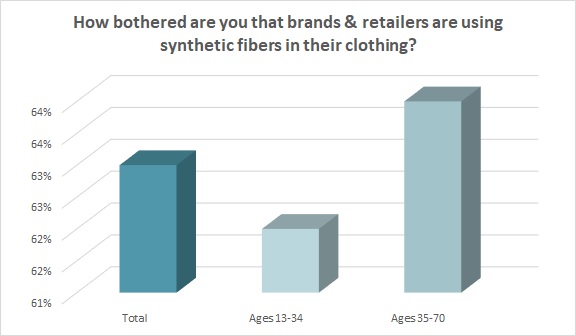On World Oceans Day this past June, the U.S. Secretary of the Interior issued an order that aims to reduce the sale and distribution of single-use plastic products and packaging, with the goal of phasing out all single-use plastic on department-managed lands by 2032. The idea is that regulations will help to force change that is better for the environment.
While other companies and sectors are decarbonizing and aiming for a circular economy…it is clear that, given its addiction to synthetic fibers, the fashion industry is heading in entirely the wrong direction.”
Synthetics Anonymous
Changing Market
However, no such orders exist for petroleum-based fibers like polyester and acrylic, whose microfibers, which are a form of microplastics, are releasing half a million tonnes of plastic microfibers into the ocean every year, according to the United Nations Environment Programme. That’s the equivalent of dumping about 275,577 cars into the ocean each year[1]. Consumer awareness of microplastic pollution has increased over the years, but the question begs: has it affected how they shop for apparel?
Back in 2018, less than 3 in 10 consumers (27 percent) said they were aware of microplastics, according to the 2022 Cotton Incorporated Lifestyle Monitor™ Survey. This year, the percentage increased significantly to 40 percent. Also back in 2018, 60 percent of the consumers who said they were aware of microfiber pollution said it would factor into their clothing purchase decision. This year, the figure increased to 65 percent. Further, nearly two-thirds of all consumers (62 percent) say they’re bothered by brands and retailers using synthetic fibers in their clothing because of the microfiber pollution.

Despite these preferences, consumers may need some help finding the sustainable apparel they favor. Changing Markets, an international sustainability foundation, released a study stating manmade fibers like polyester account for 69 percent of all materials used in textiles. In a separate study, “License to Greenwash,” Changing Markets says that in just eight years, fossil-fuel fibers are expected to represent 73 percent of all fibers used. Meanwhile, the number of garments purchased per consumer has more than doubled over the past 20 years. While the term “single-use garment” may not be applicable, the foundation says number of times a garment is used before being discarded has declined by almost 40 percent.
“People are buying more clothes because they are cheap, they are cheap because they are mostly synthetic and in this way the whole system is enabled by fossil fuels,” states the “License to Greenwash” report. “Eight of the ten [initiatives] analyzed in this report were founded between 2000 and 2018, yet in this time the production of polyester tripled from 20 million tonnes to 60 million tonnes and is projected to reach more than 90 million tonnes by 2030.”
The micro particles from manmade fiber fabrics are washed out with the effluent every time consumers launder their clothes. The U.N. Environment Programme says up to 40 percent of the microfibers that go through water treatment plants pass through to lakes, rivers and the oceans because of their small size. These fibers are then mistaken for food by fish and other marine life, which are part of the food chain.
“One of the problems is plastic ingestion at all levels of the food chain, which may pass plastic to larger animals and humans,” says U.N. Environment’s Heidi Savelli, marine environment expert. “The question is, ‘Is it acceptable to us to end up eating plastic?’ I think it’s a human right to not have to ingest plastic.”
In an effort to avoid clothing made from synthetic fibers that contribute to microfiber pollution, the majority of consumers (57 percent) say they would be more likely to check fiber content labels before purchasing clothing, according to Monitor™ research. And fully two-thirds (66 percent) say it is important that the clothes they purchase be made from materials that can biodegrade or decompose when they reach end of life.
Synthetic fibers like polyester biodegrade much more slowly than cotton. A study by Cornell University and Cotton Incorporated that measured and compared the biodegradability of fabrics in laboratory and composting environments found that after three months, polyester fabric showed only slight degradation and the fabric was still intact. By comparison, all cotton samples were significantly degraded in the lab environment and confirmed to be compostable.
In aquatic environments, polyester fibers again show very little degradation. Researchers from North Carolina State University and the University of California, Santa Barbara found that cellulosic fibers like cotton degrade significantly more than petroleum-based microfibers, leaving fewer micro particles behind.
Acknowledging consumer preferences for natural and biodegradable fabrics, some retailers seem to be making the effort to add more natural fibers to their offering. Target, for example, now offers A New Day, Universal Thread and Wild Fable, brands that all present an appreciable number of natural-fiber garments. This is significant when one considers that mass merchandise stores are where the biggest percentage of consumers (22 percent) purchase most of their clothes, according to Monitor™ research.
While consumer awareness of microfiber pollution is increasing, and shoppers are stating their preference for natural fibers that are better for the environment, Changing Markets says makers and retailers bear a responsibility to make real change. “While other companies and sectors are decarbonizing and aiming for a circular economy,” Changing Market’s “Synthetics Anonymous” report states, “it is clear that, given its addiction to synthetic fibers, the fashion industry is heading in entirely the wrong direction.”
[1] Based on the average car weight of 4,156 pounds according to the Environmental Protection Agency (EPA). https://www.bankrate.com/insurance/car/average-car-weight/
